Ecosystem-Dependent Responses of Vegetation Coverage on the Tibetan Plateau to Climate Factors and Their Lag Periods
Abstract
1. Introduction
2. Materials and Methods
2.1. Study Area
2.2. Data Collection
2.2.1. NDVI Data
2.2.2. Climate Data
2.2.3. Vegetation Type
2.3. Methods
2.3.1. Ecosystem-Dependent Sub-Regions
2.3.2. Sen’s Slope and Mann–Kendall Method
2.3.3. Lag Correlation Coefficient
2.3.4. Stepwise Regression
3. Results
3.1. The Variation Trends and Spatial Distribution Characteristics of NDVI on the Tibetan Plateau
3.2. Correlation Analysis between the NDVI in Different Vegetation Types and Climatic Factors
3.3. Interpretation of NDVI Variation with Climatic Factors
4. Discussion
4.1. Change Trends of Climate Factors and NDVI on the Tibetan Plateau
4.2. Lag in the NDVI Response to Precipitation and Temperature
4.3. Possible Mechanisms of Climate Influences on Vegetation
5. Conclusions
Author Contributions
Funding
Data Availability Statement
Acknowledgments
Conflicts of Interest
References
- Cui, X.; Graf, H.-F. Recent land cover changes on the Tibetan Plateau: A review. Clim. Chang. 2009, 94, 47–61. [Google Scholar] [CrossRef]
- Piao, S.; Fang, J.; Ji, W.; Guo, Q.; Ke, J.; Tao, S. Variation in a satellite-based vegetation index in relation to climate in China. J. Veg. Sci. 2004, 15, 219–226. [Google Scholar] [CrossRef]
- Pang, G.; Wang, X.; Yang, M. Using the NDVI to identify variations in, and responses of, vegetation to climate change on the Tibetan Plateau from 1982 to 2012. Quat. Int. 2017, 444, 87–96. [Google Scholar] [CrossRef]
- Potter, C.S.; Brooks, V. Global analysis of empirical relations between annual climate and seasonality of NDVI. Int. J. Remote Sens. 1998, 19, 2921–2948. [Google Scholar] [CrossRef]
- Tucker, C.J. Red and photographic infrared linear combinations for monitoring vegetation. Remote Sens. Environ. 1979, 8, 127–150. [Google Scholar] [CrossRef]
- Tucker, C.J.; Sellers, P.J. Satellite remote sensing of primary production. Int. J. Remote Sens. 1986, 7, 1395–1416. [Google Scholar] [CrossRef]
- Pettorelli, N.; Vik, J.O.; Mysterud, A.; Gaillard, J.-M.; Tucker, C.J.; Stenseth, N.C. Using the satellite-derived NDVI to assess ecological responses to environmental change. Trends Ecol. Evol. 2005, 20, 503–510. [Google Scholar] [CrossRef]
- Guo, B.; Zhou, Y.; Wang, S.-X.; Tao, H.-P. The relationship between Normalized Difference Vegetation Index (NDVI) and climate factors in the semiarid region: A case study in Yalu Tsangpo River basin of Qinghai-Tibet Plateau. J. Mt. Sci. 2014, 11, 926–940. [Google Scholar] [CrossRef]
- Ma, M.G.; Veroustraete, F. Interannual change trend of NDVI from 1981 to 2001 in the Heihe River Basin, China. In Proceedings of the 2nd International Vegetation User Conference, Antwerp, Belgium, 24–26 March 2004; European Commission: Bruxelles, Belgia, 2004; pp. 231–237. [Google Scholar]
- Prasad, V.K.; Badarinath, K.V.S.; Eaturu, A. Effects of precipitation, temperature and topographic parameters on evergreen vegetation greenery in the Western Ghats, India. Int. J. Clim. 2008, 28, 1807–1819. [Google Scholar] [CrossRef]
- Farrar, T.; Nicholson, S.; Lare, A. The influence of soil type on the relationships between NDVI, rainfall, and soil moisture in semiarid Botswana. II. NDVI response to soil oisture. Remote Sens. Environ. 1994, 50, 121–133. [Google Scholar] [CrossRef]
- White, M.A.; Thornton, P.; Running, S.W. A continental phenology model for monitoring vegetation responses to interannual climatic variability. Glob. Biogeochem. Cycles 1997, 11, 217–234. [Google Scholar] [CrossRef]
- Li, L.; Zhang, Y.; Liu, L.; Wu, J.; Li, S.; Zhang, H.; Zhang, B.; Ding, M.; Wang, Z.; Paudel, B. Current challenges in distinguishing climatic and anthropogenic contributions to alpine grassland variation on the Tibetan Plateau. Ecol. Evol. 2018, 8, 5949–5963. [Google Scholar] [CrossRef]
- Woodward, F.I.; Lomas, M.R.; Kelly, C.K. Global climate and the distribution of plant biomes. Philos. Trans. R. Soc. B Biol. Sci. 2004, 359, 1465–1476. [Google Scholar] [CrossRef] [PubMed]
- Zhang, X.; Wu, S.; Yan, X.; Chen, Z. A global classification of vegetation based on NDVI, rainfall and temperature. Int. J. Clim. 2016, 37, 2318–2324. [Google Scholar] [CrossRef]
- Wang, H.; Liu, D.; Lin, H.; Montenegro, A.; Zhu, X. NDVI and vegetation phenology dynamics under the influence of sunshine duration on the Tibetan plateau. Int. J. Clim. 2014, 35, 687–698. [Google Scholar] [CrossRef]
- Lin, S.; Moore, N.J.; Messina, J.P.; Wu, J. Evaluation of MODIS surrogates for meteorological humidity data in East Africa. Int. J. Remote Sens. 2013, 34, 4669–4679. [Google Scholar] [CrossRef] [PubMed]
- Woodward, F.; McKee, I. Vegetation and climate. Environ. Int. 1991, 17, 535–546. [Google Scholar] [CrossRef]
- Capecchi, V.; Crisci, A.; Lorenzo, G.; Maselli, F.; Vignaroli, P. Analysis of NDVI trends and their climatic origin in the Sahel 1986–2000. Geocarto Int. 2008, 23, 297–310. [Google Scholar] [CrossRef]
- Davenport, M.L.; Nicholson, S.E. On the relation between rainfall and the Normalized Difference Vegetation Index for diverse vegetation types in East Africa. Int. J. Remote Sens. 1993, 14, 2369–2389. [Google Scholar] [CrossRef]
- Martiny, N.; Camberlin, P.; Richard, Y.; Philippon, N. Compared regimes of NDVI and rainfall in semi-arid regions of Africa. Int. J. Remote Sens. 2006, 27, 5201–5223. [Google Scholar] [CrossRef]
- Philippon, N.; Mougin, E.; Jarlan, L.; Frison, P.-L. Analysis of the linkages between rainfall and land surface conditions in the West African monsoon through CMAP, ERS-WSC, and NOAA-AVHRR data. J. Geophys. Res. Space Phys. 2005, 110, 110. [Google Scholar] [CrossRef]
- Piao, S.; Fang, J.; Zhou, L.; Guo, Q.; Henderson, M.; Ji, W.; Li, Y.; Tao, S. Interannual variations of monthly and seasonal Normalized Difference Vegetation Index (NDVI) in China from 1982 to 1999. J. Geophys. Res. Space Phys. 2003, 108. [Google Scholar] [CrossRef]
- Wen, Z.; Wu, S.; Chen, J.; Lü, M. NDVI indicated long-term interannual changes in vegetation activities and their responses to climatic and anthropogenic factors in the Three Gorges Reservoir Region, China. Sci. Total Environ. 2017, 574, 947–959. [Google Scholar] [CrossRef] [PubMed]
- Holben, B.N. Characteristics of maximum-value composite images from temporal AVHRR data. Int. J. Remote Sens. 1986, 7, 1417–1434. [Google Scholar] [CrossRef]
- Gocic, M.; Trajkovic, S. Analysis of changes in meteorological variables using Mann-Kendall and Sen’s slope estimator statistical tests in Serbia. Glob. Planet. Chang. 2013, 100, 172–182. [Google Scholar] [CrossRef]
- Yue, S.; Pilon, P.; Cavadias, G. Power of the Mann–Kendall and Spearman’s rho tests for detecting monotonic trends in hydrological series. J. Hydrol. 2002, 259, 254–271. [Google Scholar] [CrossRef]
- Yang, Y.; Xu, J.; Hong, Y.; Lv, G. The dynamic of vegetation coverage and its response to climate factors in Inner Mongolia, China. Stoch. Environ. Res. Risk Assess. 2011, 26, 357–373. [Google Scholar] [CrossRef]
- Garonna, I.; De Jong, R.; Schaepman, M.E. Variability and evolution of global land surface phenology over the past three decades (1982–2012). Glob. Chang. Biol. 2016, 22, 1456–1468. [Google Scholar] [CrossRef]
- Zhang, Y.; Dong, S.; Gao, Q.; Liu, S.; Zhou, H.; Ganjurjav, H.; Wang, X. Climate change and human activities altered the diversity and composition of soil microbial community in alpine grasslands of the Qinghai-Tibetan Plateau. Sci. Total Environ. 2016, 562, 353–363. [Google Scholar] [CrossRef]
- Li, W.; Haiying, Y.U.; Qiang, Z.; Yunjia, X.U.; Junhu, D. Responses of aboveground biomass of alpine grass- lands to climate changes on the Qinghai-Tibet Plateau. J. Geogr. Sci. 2018, 28, 1953–1964. [Google Scholar] [CrossRef]
- Zhang, Y.L.; Song, C.H.; Band, L.E.; Sun, G.; Li, J.X. Reanalysis of global terrestrial vegetation trends from MODIS products: Browning or greening? Remote Sens. Environ. 2017, 191, 145–155. [Google Scholar] [CrossRef]
- Detsch, F.; Otte, I.; Appelhans, T.; Nauss, T. A comparative study of cross-product NDVI dynamics in the Kilimanjaro region—A matter of sensor, degradation calibration, and significance. Remote Sens. 2016, 8, 159. [Google Scholar] [CrossRef]
- You, Q.; Kang, S.; Flügel, W.-A.; Sanchez-Lorenzo, A.; Yan, Y.; Huang, J.; Martin-Vide, J. From brightening to dimming in sunshine duration over the eastern and central Tibetan Plateau (1961–2005). Theor. Appl. Clim. 2009, 101, 445–457. [Google Scholar] [CrossRef]
- Graham, E.; Mulkey, S.S.; Kitajima, K.; Phillips, N.G.; Wright, S.J. Cloud cover limits net CO2 uptake and growth of a rainforest tree during tropical rainy seasons. Proc. Natl. Acad. Sci. USA 2003, 100, 572–576. [Google Scholar] [CrossRef] [PubMed]
- Lau, K.M.; Kim, M.K.; Kim, K.M. Asian summer monsoon anomalies induced by aerosol direct forcing: The role of the Tibetan Plateau. Clim. Dyn. 2006, 26, 855–864. [Google Scholar] [CrossRef]
- Wang, Z.; Zhang, Y.; Yang, Y.; Zhou, W.; Gang, C.; Zhang, Y.; Li, J.; An, R.; Wang, K.; Odeh, I.; et al. Quantitative assess the driving forces on the grassland degradation in the Qinghai–Tibet Plateau, in China. Ecol. Inform. 2016, 33, 32–44. [Google Scholar] [CrossRef]
- Schwinning, S.; Sala, O. Hierarchy of responses to resource pulses in arid and semi-arid ecosystems. Oecologia 2004, 141, 211–220. [Google Scholar] [CrossRef] [PubMed]
- Schwinning, S.; Sala, O.; Loik, M.E.; Ehleringer, J.R. Thresholds, memory, and seasonality: Understanding pulse dynamics in arid/semi-arid ecosystems. Oecologia 2004, 141, 191–193. [Google Scholar] [CrossRef]
- Snyder, K.A.; Donovan, L.A.; James, J.J.; Tiller, R.L.; Richards, J.H. Extensive summer water pulses do not necessarily lead to canopy growth of Great Basin and northern Mojave Desert shrubs. Oecologia 2004, 141, 325–334. [Google Scholar] [CrossRef]
- Yuan-He, Y.; Shi-Long, P. Variations in grassland vegetation cover in relation to climatic factors on the Tibetan Plateau. Chin. J. Plant Ecol. 2006, 30, 1–8. [Google Scholar] [CrossRef]
- Kääb, A.; Chiarle, M.; Raup, B.; Schneider, C. Climate change impacts on mountain glaciers and permafrost. Glob. Planet. Chang. 2007, 56, 7–9. [Google Scholar] [CrossRef]
- Carlson, T. An overview of the “Triangle Method” for estimating surface evapotranspiration and soil moisture from satellite imagery. Sensors 2007, 7, 1612–1629. [Google Scholar] [CrossRef]
- Du, J.; Zhao, C.; Shu, J.; Jiaerheng, A.; Yuan, X.; Yin, J.; Fang, S.; He, P. Spatiotemporal changes of vegetation on the Tibetan Plateau and relationship to climatic variables during multiyear periods from 1982–2012. Environ. Earth Sci. 2016, 75, 1–18. [Google Scholar] [CrossRef]
- Chen, H.; Zhu, Q.; Peng, C.; Wu, N.; Wang, Y.; Fang, X.; Gao, Y.; Zhu, D.; Yang, G.; Tian, J.; et al. The impacts of climate change and human activities on biogeochemical cycles on the Qinghai-Tibetan Plateau. Glob. Chang. Biol. 2013, 19, 2940–2955. [Google Scholar] [CrossRef] [PubMed]
- Norris, J.R.; Walker, J.J. Solar and sensor geometry, not vegetation response, drive satellite NDVI phenology in widespread ecosystems of the western United States. Remote Sens. Environ. 2020, 249, 112013. [Google Scholar] [CrossRef]
- Fensholt, R.; Sandholt, I.; Proud, S.R.; Stisen, S.; Rasmussen, M.O. Assessment of MODIS sun-sensor geometry variations effect on observed NDVI using MSG SEVIRI geostationary data. Int. J. Remote Sens. 2010, 31, 6163–6187. [Google Scholar] [CrossRef]
- Morton, D.C.; Nagol, J.; Carabajal, C.C.; Rosette, J.; Palace, M.; Cook, B.D.; Vermote, E.F.; Harding, D.J.; North, P.R.J. Amazon forests maintain consistent canopy structure and greenness during the dry season. Nat. Cell Biol. 2014, 506, 221–224. [Google Scholar] [CrossRef]
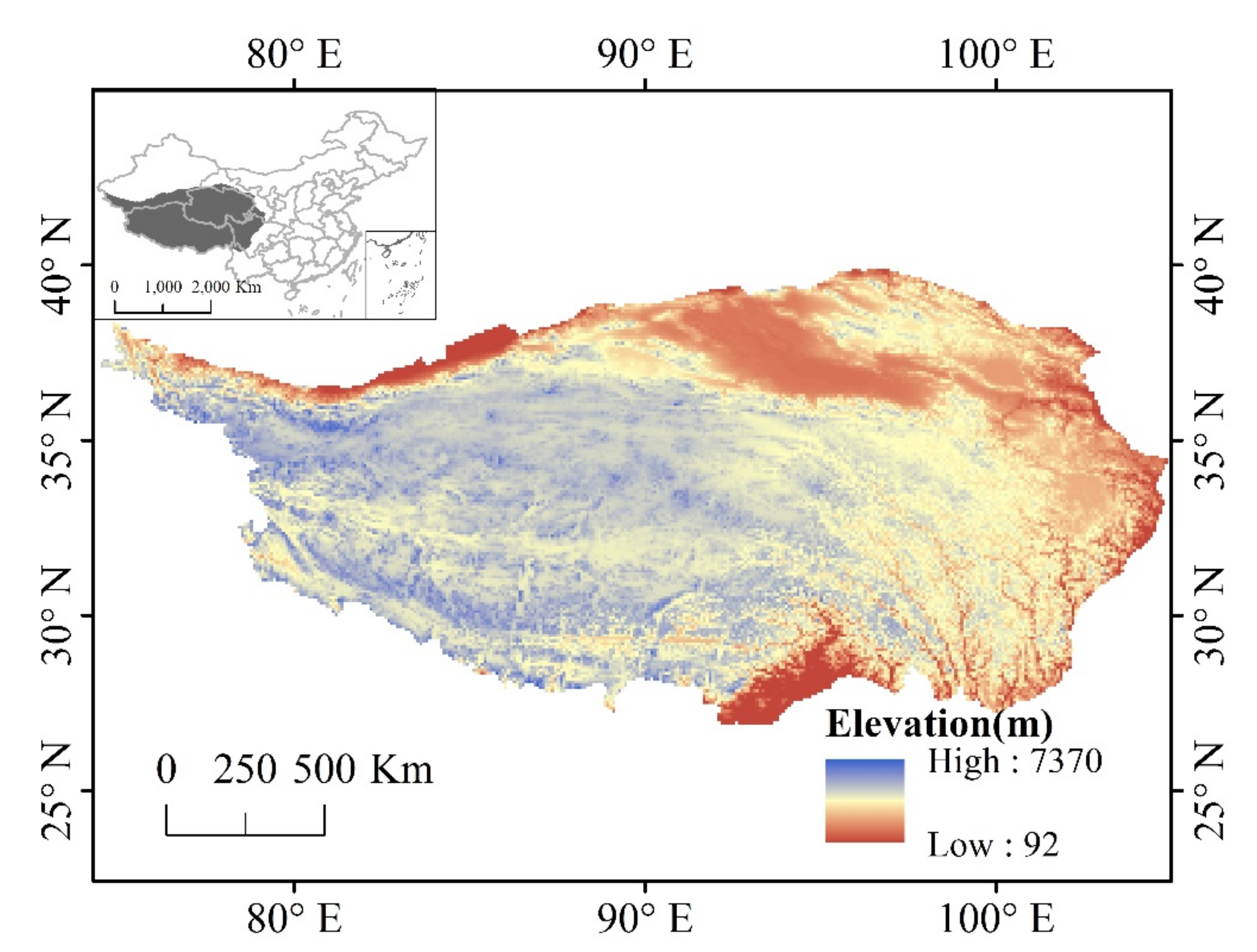
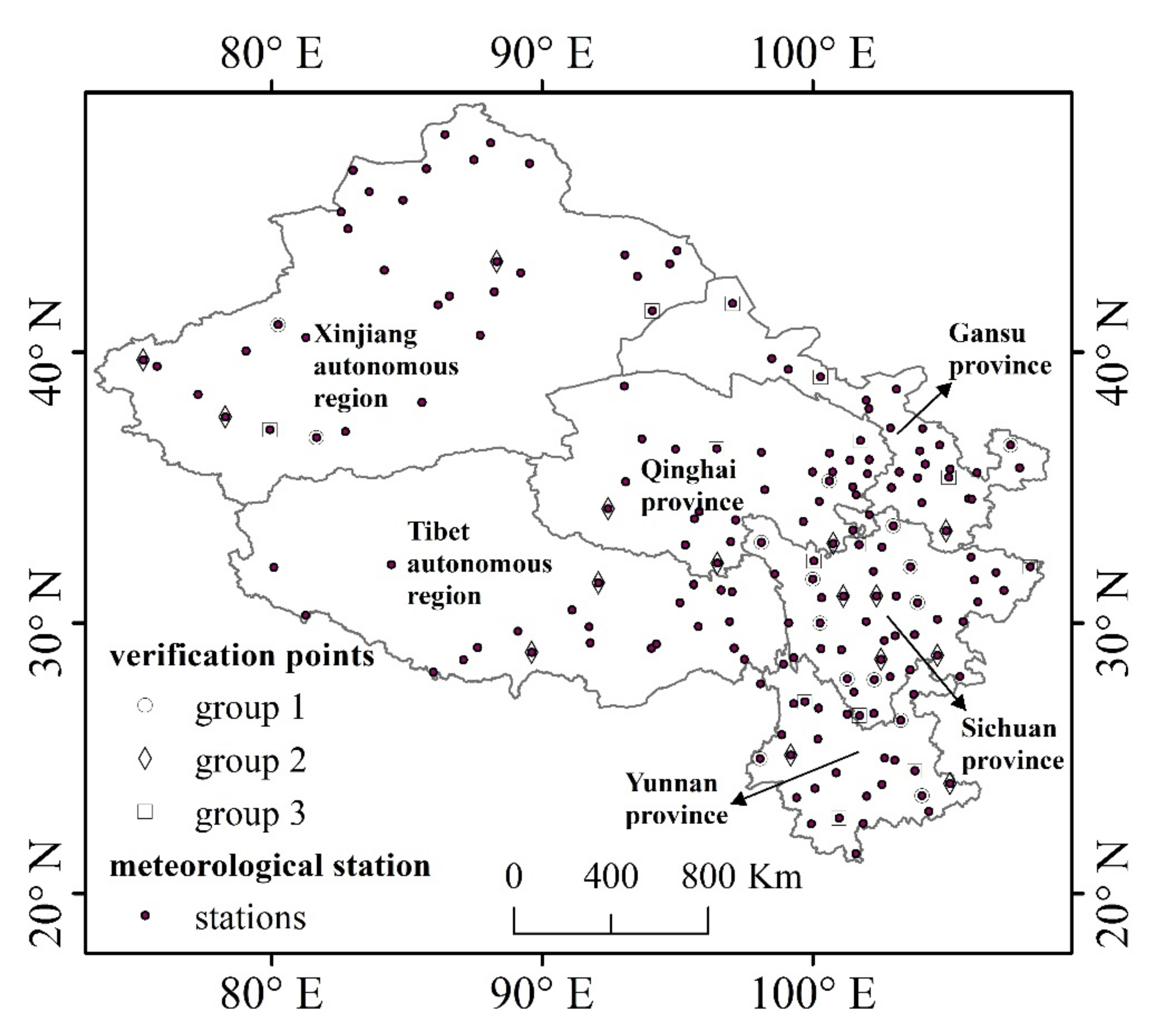

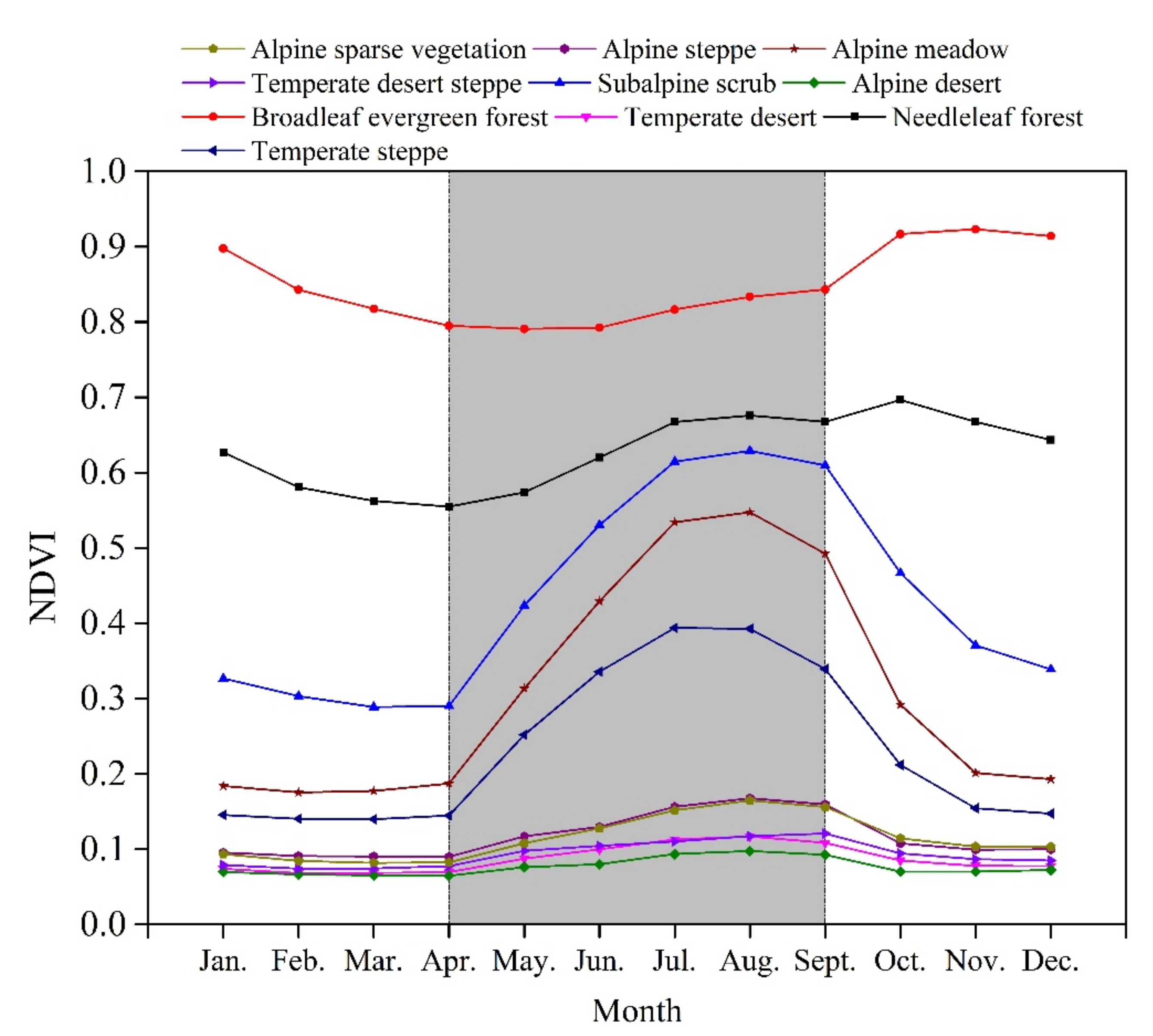
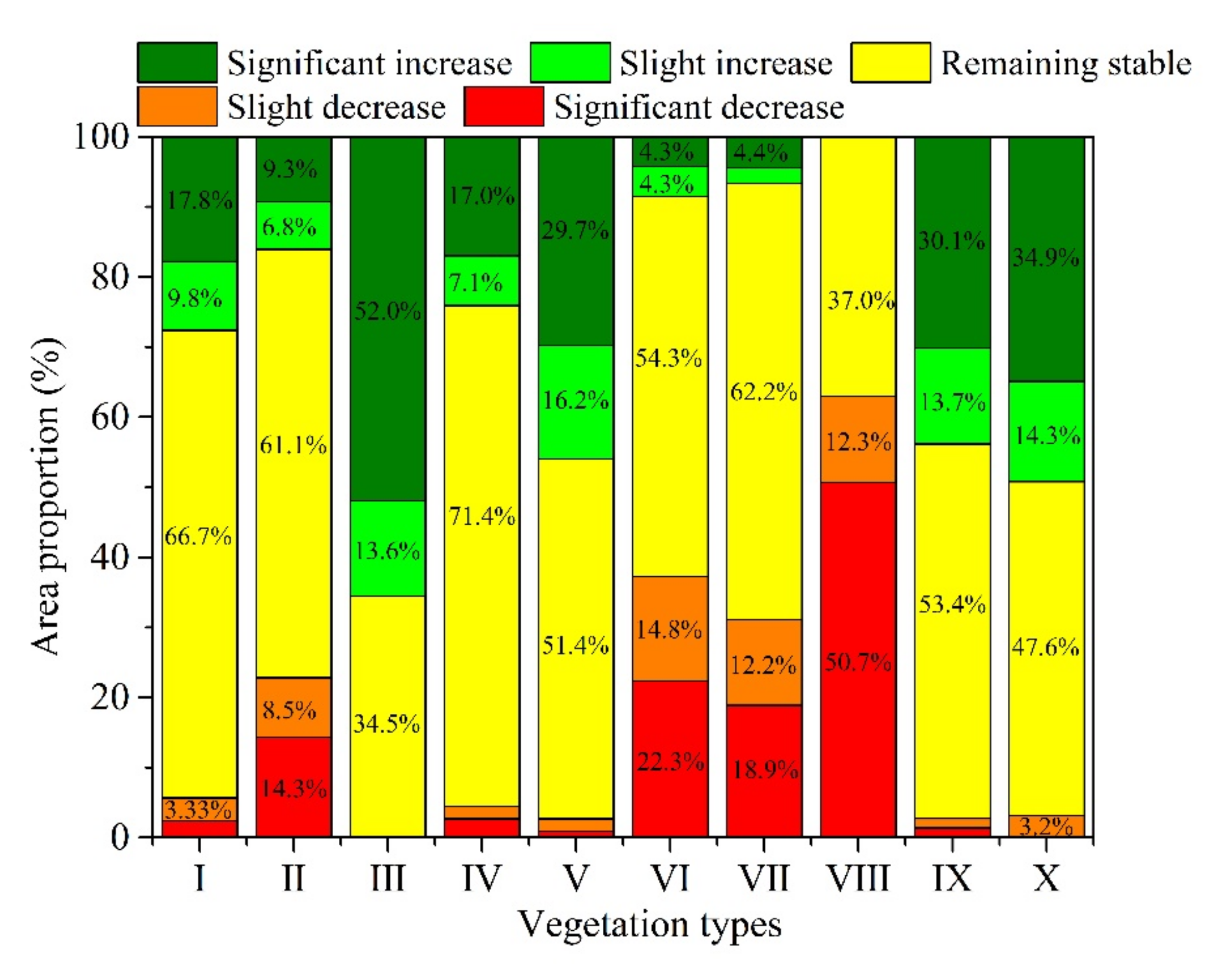

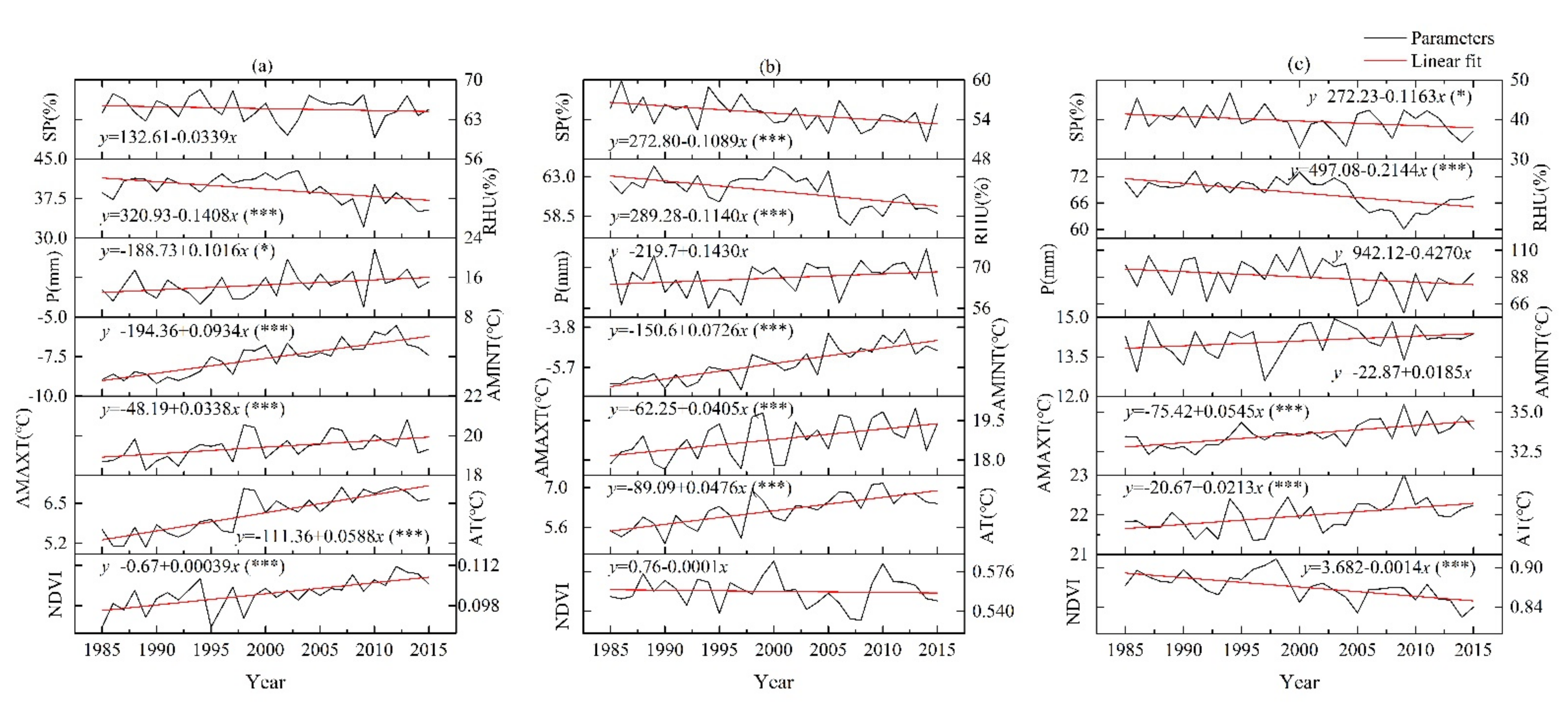
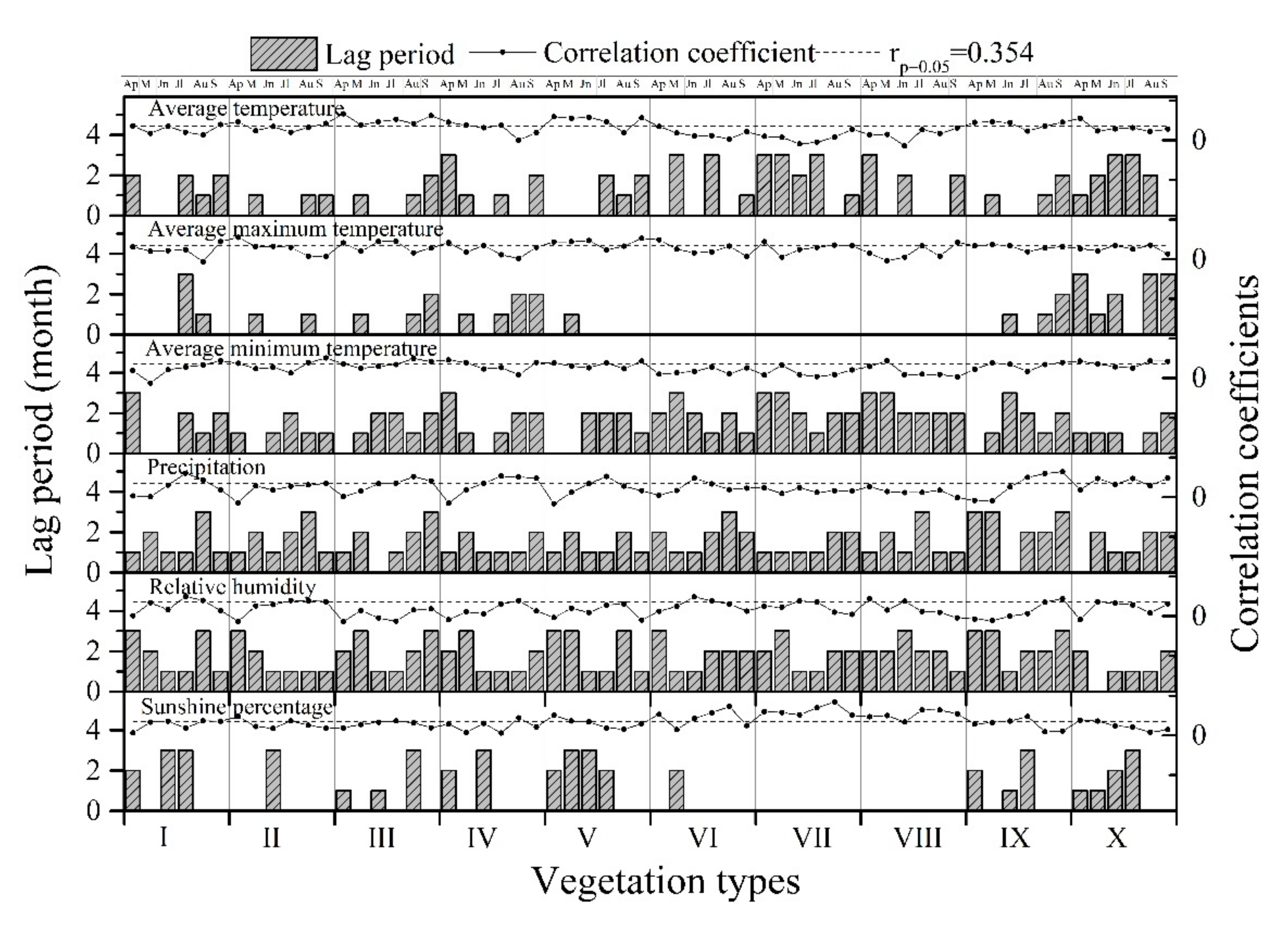
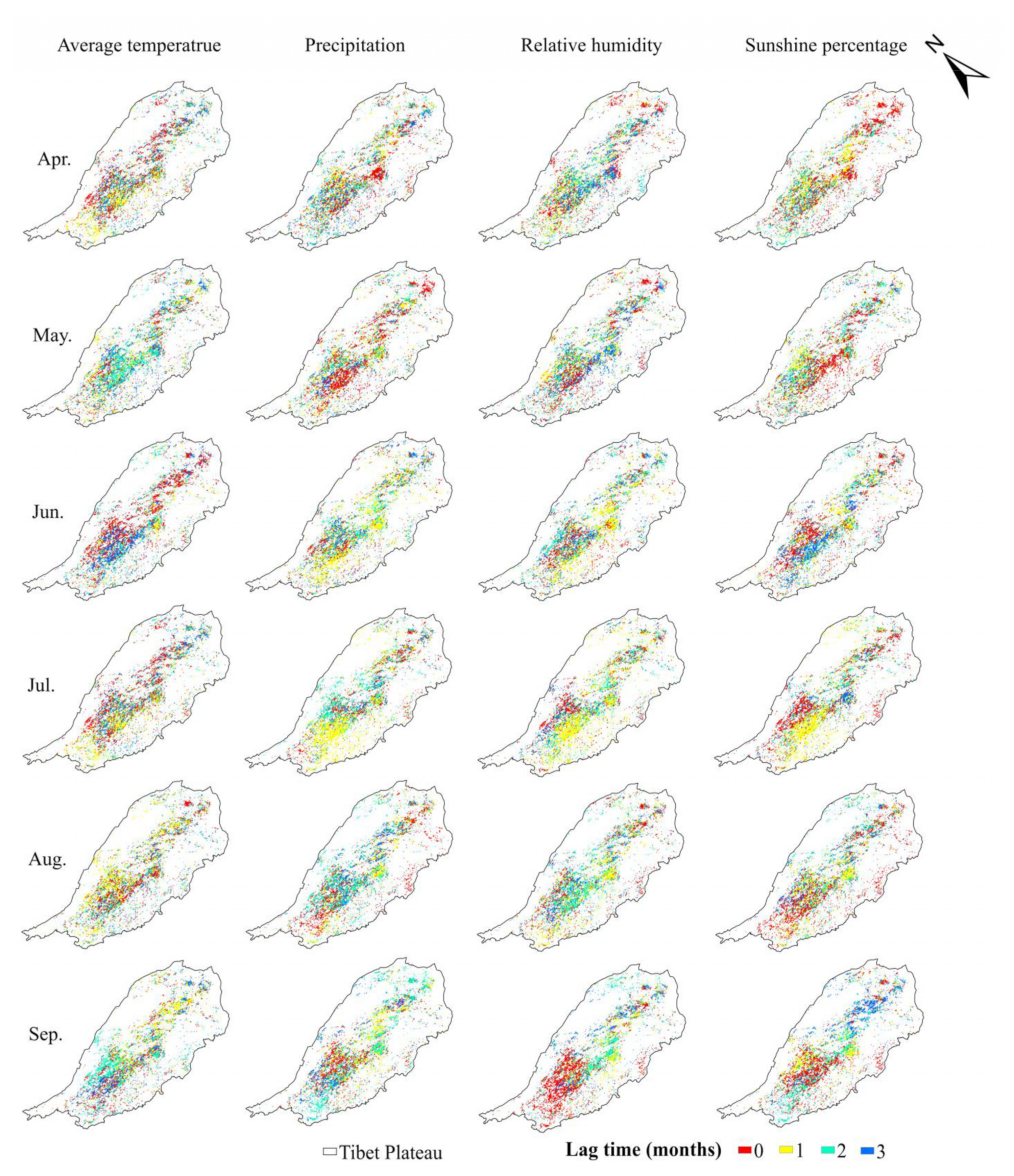
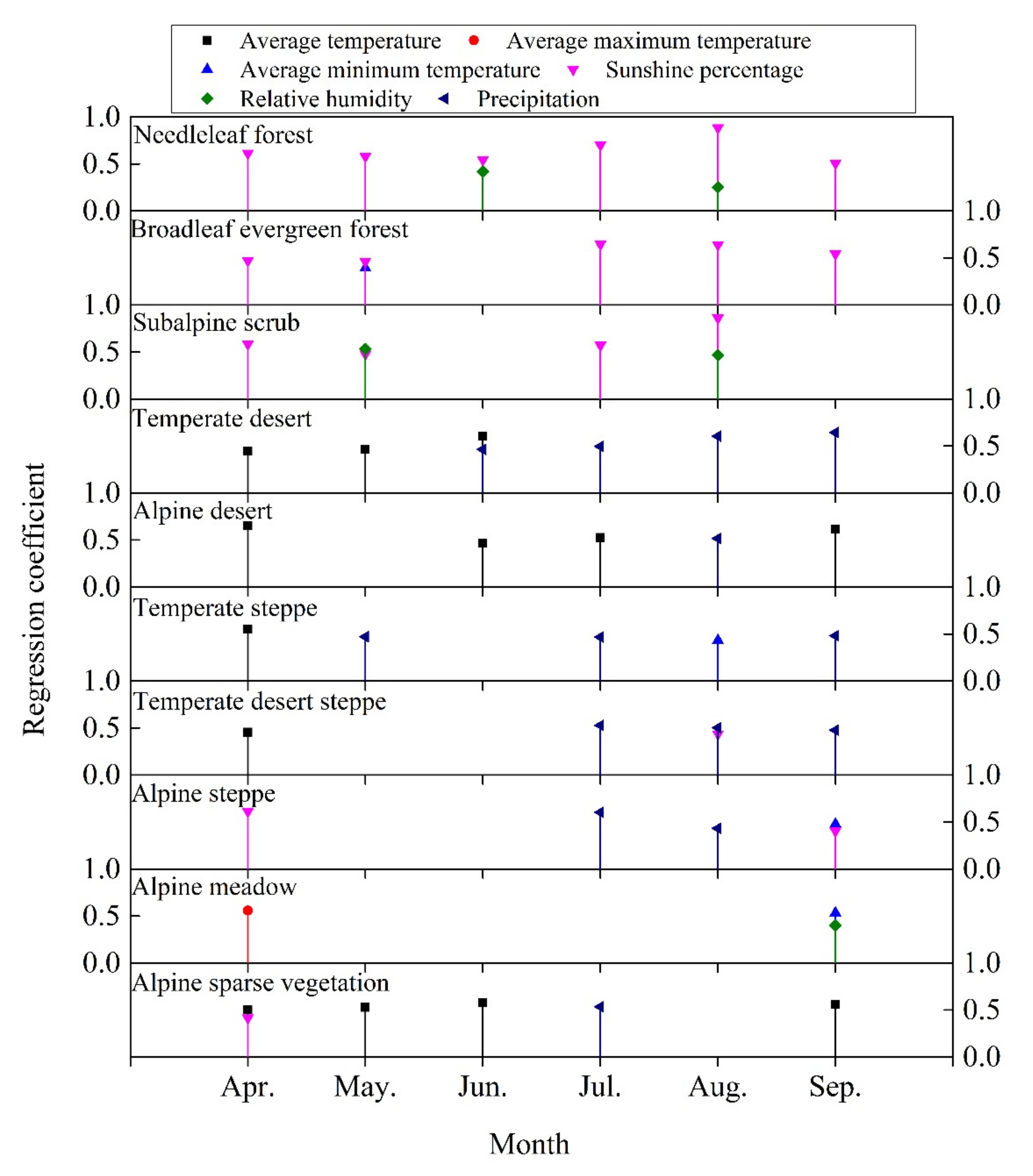
| Parameters | MAE | MRE | RMSE | |||
|---|---|---|---|---|---|---|
| Kriging | AUNSPLINE | Kriging | AUNSPLINE | Kriging | AUNSPLINE | |
| Average temperature (°C) | 1.7495 | 1.2408 | 0.099 | 0.0706 | 2.3381 | 1.7488 |
| Average minimum temperature (°C) | 1.5332 | 1.4327 | 0.1771 | 0.1655 | 2.4575 | 1.9991 |
| Average maximum temperature (°C) | 2.4547 | 1.6747 | 0.0847 | 0.0578 | 3.2046 | 2.3257 |
| Sunshine percentage (%) | 3.4083 | 4.1973 | 0.0721 | 0.0888 | 4.4182 | 5.2567 |
| Relative humidity (%) | 2.9504 | 4.9389 | 0.047 | 0.0787 | 4.5443 | 6.3366 |
| Precipitation (mm) | 23.3299 | 28.646 | 0.2275 | 0.2793 | 35.2529 | 40.0954 |
| Parameters | Subcategory | Number of Pixels |
|---|---|---|
| Alpine Steppe | Alpine Grass, Carex Steppe | 3479 |
| Alpine Meadow | Alpine Kobresia spp., Forb Meadow | 2401 |
| Alpine Desert | Alpine Tussock Dwarf Semishrubby Desert | 177 |
| Temperate Desert Steppe | Temperate Dwarf Needlegrass, Dwarf Semishrubby Desert Steppe | 112 |
| Alpine sparse vegetation | Alpine sparse vegetation | 111 |
| Subalpine Scrub | Subalpine Broadleaf Evergreen Sclerophyllous Scrub | 94 |
| Needleleaf Forest | Subtropical and Tropical Mountains Needleleaf Forest | 90 |
| Broadleaf Evergreen Forest | Subtropical Monsoon Broadleaf Evergreen forest | 73 |
| Temperate Desert | Temperate semishrubby and dwarf semishrubby desert | 73 |
| Temperate Steppe | Temperate Needlegrass Arid Steppe | 63 |
| Variables | Regions | Sub-Region 1 | Sub-Region 2 | Sub-Region 3 | Sub-Region 4 | Whole Region |
|---|---|---|---|---|---|---|
| NDVI | Sub-region 1 | 1.000 | ||||
| Sub-region 2 | 0.977 | 1.000 | ||||
| Sub-region 3 | 0.980 | 0.998 | 1.000 | |||
| Sub-region 4 | 0.981 | 0.997 | 0.999 | 1.000 | ||
| Whole region | 0.980 | 0.998 | 0.999 | 1.000 | 1.000 | |
| Average temperature | Sub-region 1 | 1.000 | ||||
| Sub-region 2 | 0.468 | 1.000 | ||||
| Sub-region 3 | 0.368 | 0.889 | 1.000 | |||
| Sub-region 4 | 0.456 | 0.944 | 0.959 | 1.000 | ||
| Whole region | 0.440 | 0.940 | 0.970 | 0.990 | 1.000 | |
| Average maximum temperature | Sub-region 1 | 1.000 | ||||
| Sub-region 2 | 0.987 | 1.000 | ||||
| Sub-region 3 | 0.985 | 0.999 | 1.000 | |||
| Sub-region 4 | 0.986 | 0.998 | 0.999 | 1.000 | ||
| Whole region | 0.986 | 0.999 | 0.999 | 1.000 | 1.000 | |
| Average minimum temperature | Sub-region 1 | 1.000 | ||||
| Sub-region 2 | 0.977 | 1.000 | ||||
| Sub-region 3 | 0.975 | 0.997 | 1.000 | |||
| Sub-region 4 | 0.974 | 0.997 | 0.999 | 1.000 | ||
| Whole region | 0.976 | 0.998 | 0.999 | 1.000 | 1.000 | |
| Sunshine percentage | Sub-region 1 | 1.000 | ||||
| Sub-region 2 | 0.991 | 1.000 | ||||
| Sub-region 3 | 0.990 | 0.999 | 1.000 | |||
| Sub-region 4 | 0.990 | 0.999 | 1.000 | |||
| Whole region | 0.991 | 0.999 | 1.000 | 1.000 | ||
| Relative humidity | Sub-region 1 | 1.000 | ||||
| Sub-region 2 | 0.989 | 1.000 | ||||
| Sub-region 3 | 0.989 | 0.998 | 1.000 | |||
| Sub-region 4 | 0.989 | 0.998 | 1.000 | 1.000 | ||
| Whole region | 0.989 | 0.998 | 1.000 | 1.000 | 1.000 | |
| precipitation | Sub-region 1 | 1.000 | ||||
| Sub-region 2 | 0.982 | 1.000 | ||||
| Sub-region 3 | 0.981 | 0.997 | 1.000 | |||
| Sub-region 4 | 0.982 | 0.998 | 0.999 | 1.000 | ||
| Whole region | 0.983 | 0.998 | 0.999 | 1.000 | 1.000 |
Publisher’s Note: MDPI stays neutral with regard to jurisdictional claims in published maps and institutional affiliations. |
© 2021 by the authors. Licensee MDPI, Basel, Switzerland. This article is an open access article distributed under the terms and conditions of the Creative Commons Attribution (CC BY) license (https://creativecommons.org/licenses/by/4.0/).
Share and Cite
Cai, S.; Song, X.; Hu, R.; Guo, D. Ecosystem-Dependent Responses of Vegetation Coverage on the Tibetan Plateau to Climate Factors and Their Lag Periods. ISPRS Int. J. Geo-Inf. 2021, 10, 394. https://doi.org/10.3390/ijgi10060394
Cai S, Song X, Hu R, Guo D. Ecosystem-Dependent Responses of Vegetation Coverage on the Tibetan Plateau to Climate Factors and Their Lag Periods. ISPRS International Journal of Geo-Information. 2021; 10(6):394. https://doi.org/10.3390/ijgi10060394
Chicago/Turabian StyleCai, Shuohao, Xiaoning Song, Ronghai Hu, and Da Guo. 2021. "Ecosystem-Dependent Responses of Vegetation Coverage on the Tibetan Plateau to Climate Factors and Their Lag Periods" ISPRS International Journal of Geo-Information 10, no. 6: 394. https://doi.org/10.3390/ijgi10060394
APA StyleCai, S., Song, X., Hu, R., & Guo, D. (2021). Ecosystem-Dependent Responses of Vegetation Coverage on the Tibetan Plateau to Climate Factors and Their Lag Periods. ISPRS International Journal of Geo-Information, 10(6), 394. https://doi.org/10.3390/ijgi10060394






